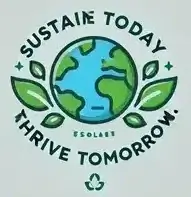Introduction
Water is essential for all life on Earth. Yet, every year, millions of people and countless animals are harmed by polluted water. From rivers filled with plastic waste to underground reservoirs contaminated by toxic chemicals, the problem is widespread and urgent.
Water pollution happens when harmful substances enter natural water sources, making them unsafe for drinking, agriculture, recreation, and supporting ecosystems. It affects rivers, lakes, oceans, and even groundwater hidden deep beneath our feet. Each type of pollution has unique causes and impacts, but all threaten our health and the environment.
In this article, you’ll discover the eight major types of water pollution, learn about their causes, understand their devastating effects, and explore practical solutions to prevent and reduce them. By the end, you’ll see why clean water matters—and how you can help protect it.
If you’d like to learn more about water pollution’s global impact, you can also visit the World Health Organization for additional information.
Many people ask, “What are the different types of water pollution?” or “What are 3, 4, or 5 types of water pollution?” In this guide, we cover 8 main types to give you a complete understanding.
Table of Contents
Types of Water Pollution
1. Groundwater Pollution
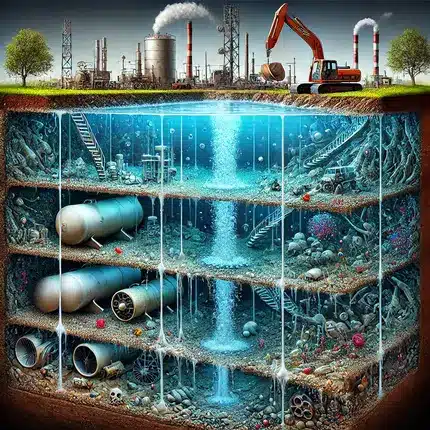
💧 What It Is
Groundwater is the water that fills the spaces between soil, sand, and rock underground. Many communities rely on it as their primary source of drinking water. When pollutants seep into the ground, they can contaminate this hidden water supply, often without any immediate visible signs.
Unlike rivers or lakes, groundwater pollution is difficult to detect and can remain unnoticed for years, silently affecting everyone who depends on wells and boreholes.
💀 Main Causes
Groundwater contamination usually happens gradually but can have serious consequences over time. Here are some of the most common causes:
- Agricultural Chemicals: Pesticides, herbicides, and chemical fertilizers applied to crops can soak into the soil. Over time, rainwater carries these substances deeper underground, where they accumulate in aquifers.
- Industrial Waste and Toxic Spills: Factories and processing plants sometimes leak hazardous chemicals through cracked containment systems or accidental spills.
- Leaking Underground Storage Tanks: Tanks that hold fuel, solvents, or waste can rust and deteriorate, releasing dangerous substances directly into the soil.
- Septic Systems and Landfills: Improperly designed or poorly maintained septic tanks can leak sewage. Similarly, landfills that lack secure liners allow leachate—a contaminated liquid—to migrate downward.
⚠️ Effects on People and the Environment
Groundwater pollution is especially dangerous because it can persist for decades. Even when the original pollution source is removed, contamination may linger underground, requiring costly cleanup efforts.
Some of the most serious effects include:
- Unsafe Drinking Water: Polluted groundwater often contains nitrates, heavy metals, and chemicals such as arsenic or benzene. Consuming contaminated water can lead to chronic health conditions.
- Serious Health Issues: Exposure to toxins in groundwater has been linked to cancer, nervous system disorders, reproductive issues, and kidney damage.
- Long-Term Environmental Damage: Contaminated groundwater can seep into rivers and lakes, harming wildlife and plants far from the source.
✅ Solutions and Prevention
Although cleaning contaminated groundwater is difficult, there are effective ways to prevent pollution and reduce risks:
- Reduce Agricultural Chemicals: Farmers can switch to organic or precision agriculture methods to apply fewer pesticides and fertilizers.
- Proper Waste Disposal: Hazardous waste should be disposed of according to safety guidelines, never dumped or buried illegally.
- Upgrade Storage Systems: Replacing old underground tanks with modern, corrosion-resistant ones can prevent leaks.
- Regular Monitoring and Regulation: Government agencies should require companies to monitor soil and groundwater quality near industrial sites and landfills.
To explore official guidelines for groundwater protection, you can visit the EPA Groundwater Contamination Page.
2. Surface Water Pollution
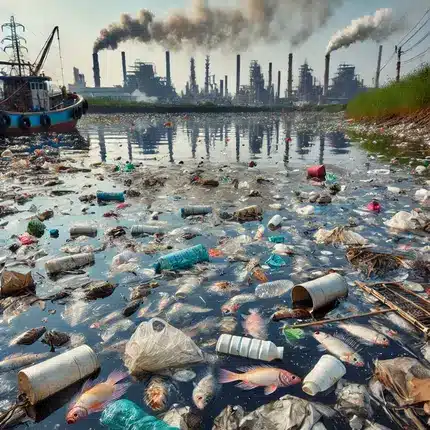
🌊 What It Is
Surface water pollution occurs when harmful substances enter visible bodies of water—rivers, lakes, ponds, reservoirs, and oceans. Unlike groundwater, which hides beneath the soil, surface water contamination is often easier to detect, especially when it involves garbage, oil slicks, or discoloration.
Unfortunately, just because it’s visible doesn’t mean it’s easy to control. Every year, industries, farms, and households release countless tons of waste into waterways, threatening drinking water, food supplies, and wildlife.
💀 Main Causes
Surface water can become polluted from a wide range of sources:
- Industrial Waste: Some factories still discharge untreated or poorly treated wastewater into rivers and streams. This water may contain toxic chemicals, heavy metals, or heated water.
- Plastic and Solid Waste: Plastic bags, bottles, and packaging materials often end up in rivers and oceans. Over time, they break into microplastics that are consumed by fish and eventually enter the human food chain.
- Untreated Sewage: In many places, sewage treatment systems are outdated or nonexistent. Raw sewage carries bacteria, viruses, and nutrients that upset natural ecosystems.
- Stormwater Runoff: When rainwater washes over streets, parking lots, and construction sites, it picks up oil, chemicals, and debris, which then flow into waterways.
⚠️ Effects on People and the Environment
Surface water pollution has immediate and visible consequences:
- Dying Fish and Aquatic Life: Pollutants reduce oxygen levels in the water and poison animals, leading to massive fish kills and biodiversity loss.
- Spread of Diseases: Untreated sewage and bacteria-laden runoff can cause cholera, dysentery, and other serious illnesses, especially in communities lacking clean drinking water infrastructure.
- Unsafe Drinking Water: Many cities and rural areas rely on rivers and lakes for water. Contamination increases treatment costs and sometimes renders water undrinkable.
- Economic Loss: Polluted waterways hurt fishing industries, tourism, and recreation, costing billions of dollars every year.
✅ Solutions and Prevention
To protect surface water, both communities and governments must take proactive measures:
- Proper Waste Treatment: Industries should treat wastewater to remove toxins before releasing it.
- Improved Sewage Systems: Building or upgrading sewage treatment facilities helps prevent harmful microorganisms and nutrients from entering rivers and lakes.
- Reduce Plastic Use: By choosing reusable products and supporting plastic bans, everyone can help cut down on pollution.
- Stronger Environmental Laws: Governments need to enforce strict regulations that penalize illegal dumping and require companies to follow sustainable practices.
If you’re interested in learning more about plastic pollution and its impact, check out the United Nations Environment Programme.
3. Microbiological Pollution
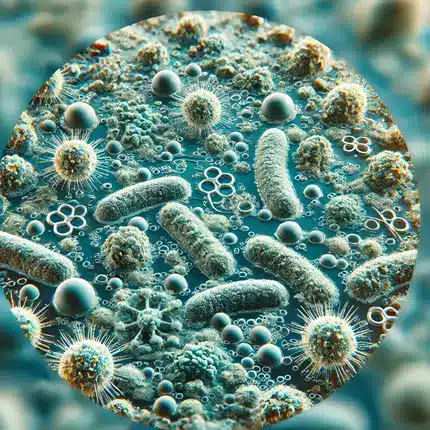
🦠 What It Is
Microbiological pollution, sometimes called biological contamination, occurs when disease-causing microorganisms—bacteria, viruses, and parasites—enter water sources. This type of pollution is especially dangerous because it is invisible to the naked eye, yet it can cause serious outbreaks of illness in humans and animals.
In many low-income regions, microbiological pollution is the most significant threat to public health. According to the World Health Organization, contaminated drinking water is responsible for millions of preventable deaths every year, especially among children.
💀 Main Causes
Microbiological contamination usually results from poor sanitation and improper waste management. The most common sources include:
- Untreated Sewage: When human waste is discharged directly into rivers, lakes, or coastal waters, it introduces pathogens such as E. coli, cholera bacteria, and hepatitis viruses.
- Animal Waste: Livestock farms often produce large quantities of manure. If not managed properly, rainwater runoff carries bacteria and parasites into nearby streams and ponds.
- Poor Hygiene Infrastructure: In some communities, open defecation and lack of proper toilets allow fecal matter to seep into groundwater and surface water.
- Flooding and Natural Disasters: Heavy rains or floods can overwhelm sanitation systems, mixing sewage with drinking water supplies.
⚠️ Effects on People and the Environment
The consequences of microbiological pollution can be severe and widespread:
- Waterborne Diseases: Contaminated water can spread cholera, typhoid fever, dysentery, hepatitis A, and parasitic infections like giardiasis.
- High Infant Mortality: Infants and young children are especially vulnerable. Diarrheal diseases linked to unsafe water are a leading cause of child deaths in many developing countries.
- Economic Burden: Families and governments must spend large sums on healthcare, lost productivity, and emergency water supplies.
- Threat to Aquatic Life: Some pathogens also affect fish and amphibians, disrupting food chains and harming biodiversity.
✅ Solutions and Prevention
Preventing microbiological pollution requires improvements in sanitation, infrastructure, and public awareness:
- Invest in Sewage Treatment: Modern treatment facilities can remove most pathogens from wastewater before it is discharged.
- Protect Water Sources: Establishing buffer zones around rivers and lakes helps prevent contamination from animal waste and human activity.
- Educate Communities: Public health campaigns that teach safe hygiene practices—like handwashing and using latrines—are crucial.
- Provide Clean Drinking Water: Simple solutions such as chlorination, filtration, and protected wells dramatically reduce disease risk.
For additional information about preventing waterborne diseases, you can explore the Centers for Disease Control and Prevention.
4. Chemical Water Pollution

☠️ What It Is
Chemical water pollution happens when harmful synthetic substances mix with natural water sources. Unlike bacteria or organic waste, chemicals can be extremely persistent in the environment, sometimes remaining toxic for decades.
This type of pollution is particularly alarming because many chemicals are invisible and tasteless. People may consume contaminated water for years without realizing it contains dangerous substances.
From heavy metals in industrial effluents to pesticide residues in agricultural runoff, chemical water pollution affects every continent and poses a serious threat to human health and wildlife.
💀 Main Causes
Chemical contaminants reach rivers, lakes, groundwater, and oceans through several channels:
- Industrial Waste: Factories and mining operations often discharge wastewater loaded with heavy metals like mercury, lead, cadmium, and arsenic. These elements are highly toxic even at low concentrations.
- Agricultural Runoff: Farms apply pesticides, herbicides, and fertilizers to improve crop yields. Rainwater can wash these chemicals into nearby streams or seep into underground aquifers.
- Oil Spills: Accidental releases of crude oil from tankers or drilling rigs pollute coastal waters. Even small spills can devastate marine ecosystems.
- Household Chemicals: Everyday products—cleaning agents, paints, solvents, and pharmaceuticals—frequently end up in wastewater systems that are not designed to remove them completely.
- Landfill Leachate: Rainwater filtering through landfills absorbs chemicals that can leak into groundwater.
⚠️ Effects on People and the Environment
The consequences of chemical water pollution are often severe and long-lasting:
- Toxicity in Drinking Water: Consuming water contaminated with heavy metals or industrial chemicals can cause neurological damage, cancer, reproductive issues, and developmental problems in children.
- Death of Aquatic Life: Chemical pollutants disrupt the reproductive systems of fish and amphibians, causing population declines and even species extinction.
- Bioaccumulation: Certain chemicals build up in the bodies of small organisms. As predators eat these organisms, toxins concentrate higher in the food chain, eventually reaching humans.
- Damage to Soil and Crops: When contaminated water irrigates farmland, toxic substances accumulate in the soil, reducing agricultural productivity and harming food safety.
✅ Solutions and Prevention
Addressing chemical water pollution requires a combination of regulation, innovation, and personal responsibility:
- Stricter Regulations: Governments must enforce environmental laws that limit how much waste industries can release into waterways.
- Eco-Friendly Farming: Farmers can adopt integrated pest management and organic methods to reduce pesticide use.
- Better Industrial Practices: Modern factories use closed-loop systems to recycle wastewater, minimizing discharge.
- Quick Spill Response: Oil spill response teams and containment measures should be in place to rapidly address accidents.
- Household Choices: Consumers can switch to biodegradable cleaning products and safely dispose of unused medications.
If you’d like to explore more about chemical contamination and its impacts, visit the National Geographic Water Pollution Resource.
5. Thermal Pollution
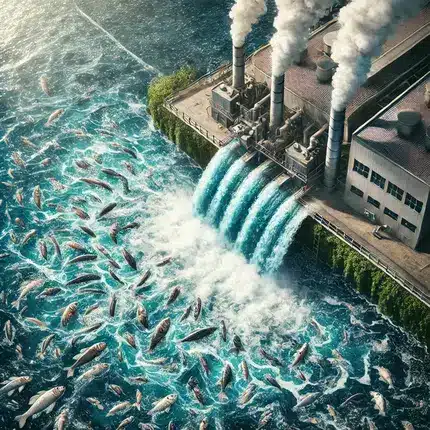
🔥 What It Is
Thermal pollution occurs when human activities significantly raise the temperature of natural water bodies. While it may sound harmless compared to toxic waste or oil spills, excess heat disrupts delicate aquatic ecosystems and can be just as destructive over time.
Water naturally regulates temperature for countless species. When factories, power plants, or industrial facilities discharge heated water, it lowers the oxygen content and alters habitat conditions, putting fish and other organisms at risk.
💀 Main Causes
Thermal pollution typically results from a combination of industrial processes and environmental changes:
- Power Plants and Factories: Facilities that use water as a coolant often return it to rivers or lakes much hotter than before. This sudden temperature change, called “thermal shock,” kills or displaces sensitive species.
- Deforestation: Trees and vegetation provide shade that keeps streams and ponds cool. Removing forests allows sunlight to heat water surfaces.
- Urban Runoff: Rainwater flowing over asphalt and concrete absorbs heat before draining into waterways.
- Climate Change: Global warming raises baseline water temperatures, compounding the effects of local heat sources.
⚠️ Effects on People and the Environment
Thermal pollution harms ecosystems in multiple ways:
- Reduced Oxygen Levels: Warmer water holds less dissolved oxygen. Fish and invertebrates suffocate or are forced to migrate.
- Loss of Biodiversity: Species adapted to narrow temperature ranges may disappear from affected areas.
- Algae Blooms: Warm water accelerates algae growth. Algal blooms consume oxygen and release toxins, harming aquatic life.
- Disrupted Reproduction: Many fish and amphibians rely on seasonal temperature cues to spawn. Constantly elevated temperatures interfere with breeding cycles.
Though thermal pollution doesn’t always produce immediate human health risks, it can devastate fisheries, drinking water supplies, and recreation.
✅ Solutions and Prevention
Fortunately, there are effective ways to limit thermal pollution:
- Cooling Ponds and Towers: Power plants can install systems to dissipate heat before discharging water back into rivers or lakes.
- Riparian Planting: Restoring trees and vegetation along water bodies helps shade and cool the water naturally.
- Heat Recovery Technologies: Industries can capture waste heat for reuse in other processes, reducing the temperature of water effluents.
- Urban Planning: Designing cities with more green spaces and permeable surfaces limits heat absorption and runoff.
If you’d like to explore more about industrial thermal impacts, visit the Environmental Protection Agency.
6. Oxygen-Depleting Pollution
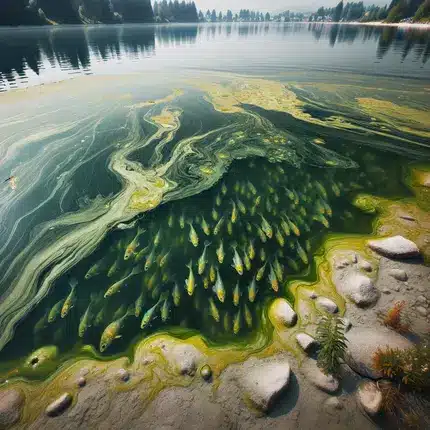
😷 What It Is
Oxygen-depleting pollution happens when large amounts of organic matter or nutrients enter a water body, causing microorganisms to grow out of control. As bacteria break down this excess material, they consume vast amounts of dissolved oxygen, leaving too little for fish, plants, and other aquatic life.
This process can transform healthy waterways into “dead zones”—areas where almost nothing can survive.
💀 Main Causes
Several human activities contribute to oxygen depletion in rivers, lakes, and oceans:
- Agricultural Runoff: Fertilizers used on farms are rich in nitrogen and phosphorus. Rainwater carries these nutrients into streams, sparking massive algae blooms.
- Untreated Sewage: Discharging raw sewage or poorly treated wastewater adds organic waste and bacteria that strip oxygen from the water.
- Industrial Discharges: Food processing plants, slaughterhouses, and paper mills often release nutrient-laden waste into waterways.
- Stormwater Pollution: Heavy rain flushes organic debris, animal waste, and yard clippings into rivers.
⚠️ Effects on People and the Environment
Oxygen-depleting pollution has profound and sometimes irreversible consequences:
- Dead Zones: Large areas of ocean and freshwater ecosystems become uninhabitable for fish, crustaceans, and other organisms.
- Mass Fish Deaths: When oxygen levels suddenly drop, entire fish populations can die within hours.
- Toxic Algal Blooms: Excess nutrients trigger blooms of cyanobacteria, which can produce toxins harmful to humans and animals.
- Water Quality Decline: Decomposing organic matter fouls water with foul odors and sludge, making it unsafe for drinking and recreation.
One of the world’s largest dead zones is in the Gulf of Mexico, where nutrient runoff from farms along the Mississippi River fuels algae blooms that choke marine life every summer.
✅ Solutions and Prevention
Reducing oxygen-depleting pollution requires changes in farming, waste management, and urban development:
- Nutrient Management: Farmers can adopt precision agriculture techniques to use fewer fertilizers and prevent runoff.
- Upgrading Wastewater Treatment: Modern treatment plants remove organic material and nutrients before discharging water.
- Protecting Wetlands: Wetlands act as natural filters that trap nutrients and sediments before they reach rivers.
- Buffer Strips: Planting vegetation along waterways helps absorb excess nutrients and slows runoff.
To learn more about nutrient pollution and its impact, visit the United States Environmental Protection Agency’s Nutrient Pollution page.
7. Oil Pollution
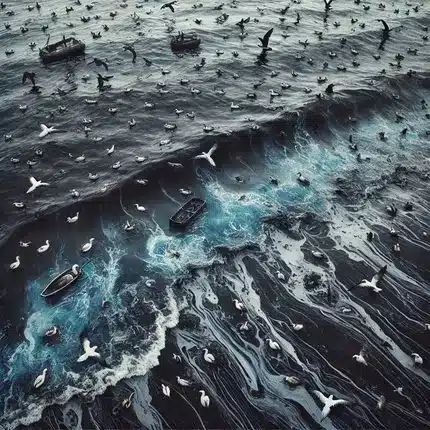
🛢 What It Is
Oil pollution occurs when petroleum products spill or leak into oceans, rivers, and coastal areas. Oil forms a thick, toxic layer on the water’s surface, blocking sunlight and oxygen exchange. While spectacular tanker disasters make headlines, small but frequent leaks from ships, pipelines, and land-based activities also contribute significantly to this form of pollution.
Unlike some contaminants, oil doesn’t dissolve in water. Instead, it spreads quickly, coating everything it touches in a sticky, poisonous film.
💀 Main Causes
Oil pollution has multiple sources, both accidental and intentional:
- Tanker Accidents: Large oil tankers can spill millions of gallons of crude oil during collisions or groundings.
- Offshore Drilling: Platforms extracting oil from beneath the ocean floor sometimes suffer blowouts or leaks.
- Pipeline Leaks: Underground or undersea pipelines can rupture due to corrosion, poor maintenance, or natural disasters.
- Illegal Dumping: Some ships illegally discharge oily waste or bilge water into the sea to avoid disposal fees.
- Runoff from Land: Used motor oil and industrial lubricants often find their way into storm drains and waterways.
⚠️ Effects on People and the Environment
Oil pollution is one of the most visually devastating types of contamination, harming countless species and entire ecosystems:
- Marine Animals: Oil coats the feathers of birds, destroying their insulation and buoyancy. Seabirds often die from hypothermia or drown.
- Fish and Shellfish: Toxic compounds in oil damage the gills and organs of marine life, leading to suffocation or poisoning.
- Beaches and Coastal Communities: Oil slicks ruin beaches, impact tourism, and require costly cleanup operations.
- Long-Term Damage: Even after visible oil is removed, residues remain in sediments and food chains for decades.
One famous example is the 1989 Exxon Valdez spill, which released nearly 11 million gallons of crude oil into Alaska’s Prince William Sound. The effects are still felt today.
✅ Solutions and Prevention
Oil pollution prevention combines regulation, technology, and public awareness:
- Strict Regulations and Enforcement: Governments must enforce rules that require double-hulled tankers, regular inspections, and spill response plans.
- Improved Cleanup Methods: Advances in skimmers, booms, and biological agents (bioremediation) help clean spills more effectively.
- Proper Waste Disposal: Mechanics and industries should collect and recycle used oil rather than dumping it.
- Transition to Renewables: Reducing reliance on fossil fuels decreases the risk of oil-related disasters.
For more information about oil spill prevention and response, visit the National Oceanic and Atmospheric Administration.
8. Suspended Matter Pollution
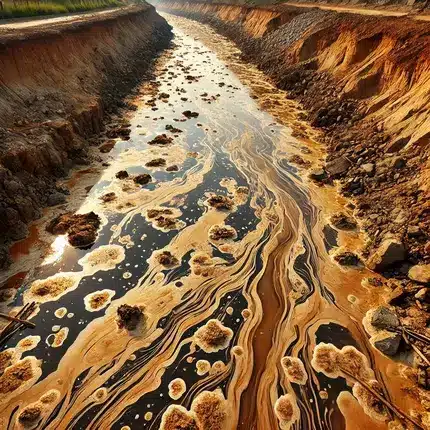
🌫 What It Is
Suspended matter pollution occurs when solid particles—such as soil, silt, sand, and industrial debris—float in water instead of dissolving. While some sediment naturally enters rivers and lakes, excessive amounts from human activities can cloud the water, reduce light penetration, and smother aquatic habitats.
This type of pollution is often called turbidity because it makes water look dirty or murky. Though it may appear less hazardous than chemicals or oil, it causes significant damage to ecosystems over time.
💀 Main Causes
Suspended matter pollution comes from a variety of land-based activities:
- Soil Erosion: Deforestation and poor farming practices remove protective vegetation. During rainstorms, exposed soil washes into nearby streams.
- Construction Sites: Building roads, houses, and industrial facilities often generates loose soil and debris that runoff carries into waterways.
- Mining Operations: Open-pit mining and excavation stir up sediment that can travel long distances in rivers.
- Industrial Waste Discharges: Factories may release particles from manufacturing processes directly into water bodies without proper filtration.
⚠️ Effects on People and the Environment
Suspended particles harm water quality and aquatic life in several ways:
- Reduced Sunlight: Murky water blocks sunlight from reaching underwater plants, slowing photosynthesis and depleting oxygen.
- Clogged Fish Gills: Fine sediments damage or clog the gills of fish and other aquatic organisms, leading to suffocation or infection.
- Disrupted Food Chains: Particles smother fish eggs and insects, reducing survival rates for many species.
- Decreased Drinking Water Quality: Excessive sediment increases water treatment costs and sometimes carries attached pollutants like heavy metals and pesticides.
Suspended matter pollution also affects humans indirectly by harming fisheries, drinking water supplies, and recreational areas.
✅ Solutions and Prevention
Reducing sediment pollution requires a combination of good land management and industrial practices:
- Reforestation and Vegetation Cover: Planting trees and maintaining ground cover helps stabilize soil and prevent erosion.
- Erosion Control Measures: Silt fences, terracing, and sediment ponds at construction sites trap sediment before it reaches rivers.
- Responsible Mining Practices: Mining companies should implement sediment control systems to capture runoff.
- Better Industrial Filtration: Factories can install filters and sedimentation tanks to remove particles from wastewater before discharging it.
If you’re interested in learning more about sediment pollution and management, visit the U.S. Geological Survey.
Conclusion: How to Reduce Water Pollution
Water pollution is one of the most pressing environmental challenges of our time. But it’s also preventable. By understanding the different types—from oil spills to chemical contamination—and recognizing their causes and effects, we can take meaningful action to protect our health and our planet.
Frequently Asked Questions (FAQ)
What are the 8 main types of water pollution?
The main types are surface water pollution, groundwater pollution, microbiological pollution, chemical pollution, thermal pollution, oxygen-depleting pollution, oil pollution, and suspended matter pollution.
What is the most common cause of water pollution?
Agricultural runoff is the leading cause worldwide. Fertilizers and pesticides from farms often wash into rivers, followed by untreated sewage and factory waste.
How does water pollution affect human health?
It can cause diarrhea, cholera, cancer, nerve damage, and reproductive problems. Contaminated water is a major global health risk, especially in low-income areas.
What are some examples of chemical water pollution?
Examples include pesticides, heavy metals like mercury and lead, industrial waste, and oil spills—all of which can poison humans and wildlife.
How can individuals reduce water pollution at home?
You can help by using fewer chemicals, avoiding plastic waste, using natural cleaners, reducing lawn fertilizers, and maintaining your septic system.
What is a dead zone in the ocean or rivers?
A dead zone is an area with almost no oxygen in the water. It happens when pollution causes algae to grow, die, and decompose, removing oxygen and killing marine life.
Why is plastic pollution so harmful to water bodies?
Plastic breaks down into microplastics that are eaten by fish and animals. It pollutes oceans, harms ecosystems, and can even end up in our drinking water and food.
What are some modern solutions to stop water pollution?
Modern solutions to stop water pollution include natural methods like bioremediation (using microbes to clean pollutants), stricter environmental regulations, green infrastructure (like rain gardens and permeable pavements), and community clean-up initiatives. These approaches help prevent and reduce pollution at both local and global levels.
About the Author
Soumen Chakraborty is an environmental blogger and researcher passionate about making complex sustainability topics easy to understand. He writes in-depth guides on pollution, climate change, and conservation to help readers take informed action.
When he’s not writing, Soumen enjoys exploring nature, supporting local clean-up campaigns, and sharing ideas about protecting our planet. You can find more of his work on greenglobe25.in and connect with him on social media to join the conversation about a cleaner, healthier world.
Last update on 06 July 2025
✅ What You Can Do Today
- Never dump trash, oil, or chemicals into drains or waterways.
- Reduce your plastic consumption and recycle whenever possible.
- Support policies and organizations working to improve water quality.
- Share knowledge with friends and family to raise awareness.
Together, these efforts help preserve clean, safe water for future generations.
💬 What do you think? Share your thoughts in the comments!
